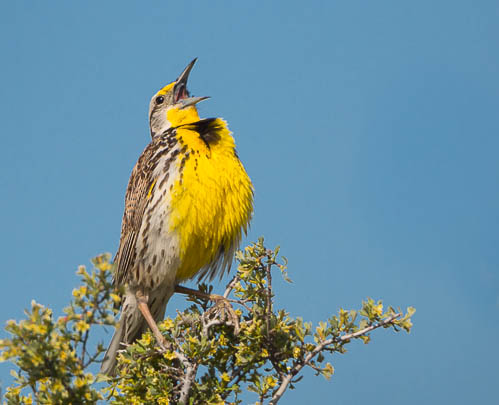
I started using audio to attract birds for photography three years ago, after participating in shoots with other photographers and experiencing the productive advantage audio reveals. By playing a recording of a target bird’s song, a shy bird can often be quickly drawn to within useful photographic range. It’s a powerful tool, a tool that should make one wary — very wary — of abusing.
My recording system is simple. I use an 8GB iPod Touch, BirdTunes app, Aluratek Bluetooth receiver and NMDX compact speakers. The moderately-expensive iPod goes for around $200, but a iPhone (or smart phone with an alternate bird app) will work just the same. The BirdTunes app (not available for android) is the choice for many pros, with outstanding ease-of-use and a cost of $10 (I’ve also used the iBird Explorer Pro, but prefer BirdTunes). For each bird, BirdTunes has selections for regional dialects, as well as various clicks and calls that each species makes. All of them can be useful. A typical recording repeats a song three times with a touch start. BirdTunes also has a rather dangerous, continuous play repeat option that I strongly recommend against using. I find continuous play annoying, and frankly, it’s unethical. It interferes with the actual bird’s song, stresses the bird and blocks your own ears from hearing (and enjoying) the real thing. It’s also unnecessary.

The weak link in my system is the Bluetooth. I’m using an Aluratek receiver from Newegg. It works to a just usable 30 feet. If you exceed that range, you lose the connection and have to re-connect by moving closer. Battery life is another issue. The Aluratek charges via USB, with power lasting for a few hours, enough for a morning and evening in the field. It’s the weak link because my iPod and speaker batteries outlast it. As with most battery powered devices these days, you need to have a power source and the appropriate cables in the field (car), so you can re-charge between sessions.
A hardware problem I encountered was mating the speakers with the receiver, since both had male connectors. The solution was a $2 3.5mm female-female audio connector that I sourced at local electronics store.
For about the same price as my receiver, you could get a pair of 20 ft 3.5mm headphone cables from Radio Shack, and wire directly from speaker to iPod. This would avoid the receiver battery drain issue, and trade the hassle of Bluetooth wireless for the hassle of deploying and retrieving the cable line.
I charge all devices the day before a shoot. My receiver is always plugged into (and inside) the speaker case, including while charging. I put the iPod inside the speaker case after it gets charged, zip up the case, and place it in my camera belt pack where it’s ready for retrieval.

Chances are the bird will first appear in the brush, hidden or partly hidden, searching for an intruder. Finding none, it may hop up on your favored perch and sing, and if you act quickly you’ve got the shot. If the bird seems reluctant to appear, you’re probably too close. Step back a bit and try again, or, move to another site and find a more co-operative bird. Wearing camouflage improves your odds with many species.
Playing recorded bird song is generally prohibited in National Parks or Wildlife Refuges, and many state parks as well. Don’t use recordings along popular trails, with threatened or endangered species, or if your target shows signs of stress. Used ethically, attracting birds with song can be educational, and an efficient way to further your bird photography in the field.